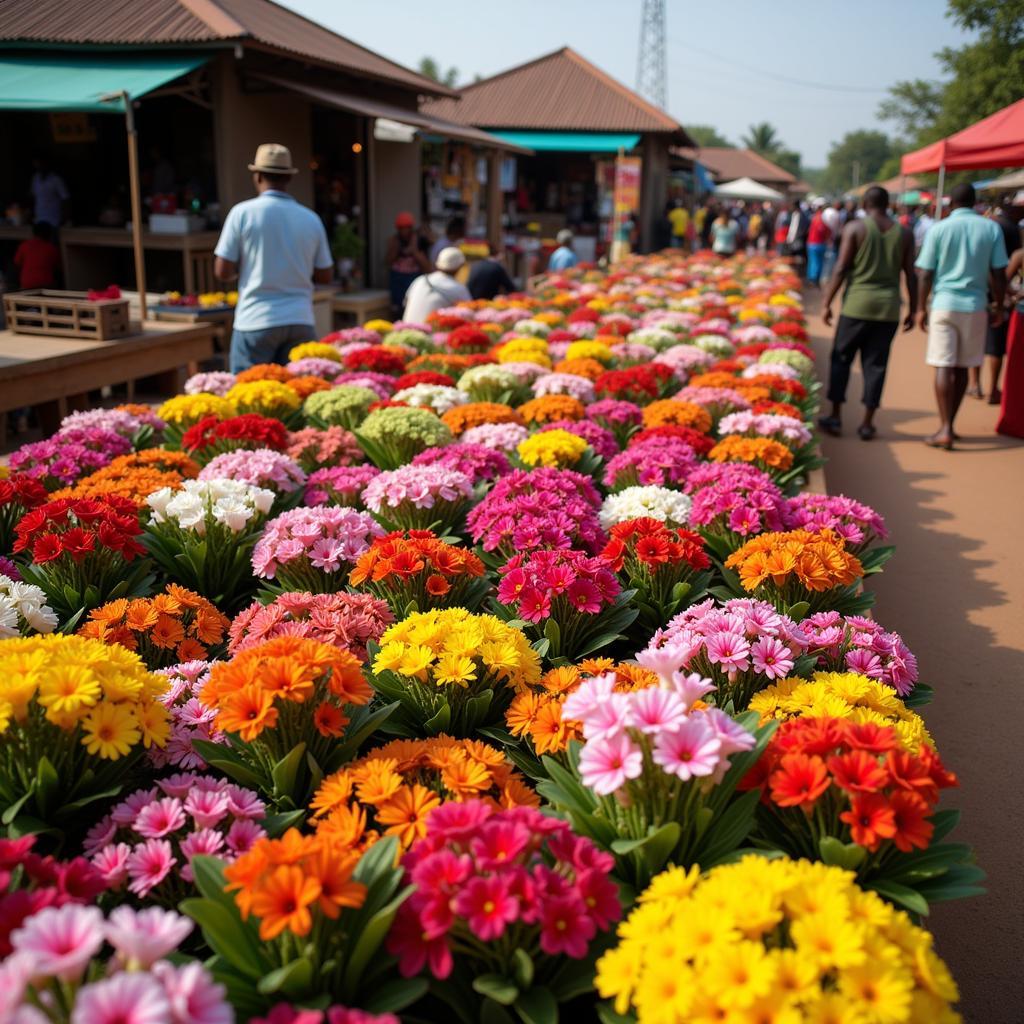African Countries By Area: A Comprehensive Guide to the Largest Nations on the Continent
Africa, the second-largest continent in the world, is a diverse landmass with a rich tapestry of cultures, languages, and landscapes. Its immense size is a defining characteristic, and exploring the vastness of its geographical expanse often starts with understanding its largest countries. This comprehensive guide delves into the top African nations by area, providing insightful information about their unique features, historical context, and cultural significance.
Top 10 African Countries by Area
Here’s a list of the largest countries in Africa, ranked by land area:
- Algeria: Spanning over 2,381,741 square kilometers, Algeria is the largest country in Africa and the tenth largest in the world. Its vast desert landscapes and diverse ecosystems, including the Sahara Desert, Atlas Mountains, and coastal plains, contribute to its expansive size.
- Democratic Republic of the Congo: With a land area of 2,344,858 square kilometers, the Democratic Republic of the Congo is the second-largest country in Africa and the eleventh largest in the world. Its vast rainforests, mineral wealth, and complex political history are hallmarks of its expansive size.
- Sudan: Sudan, with a land area of 1,886,068 square kilometers, occupies the third position in Africa. Its diverse geography, including the Nile River, the Sahara Desert, and the Red Sea coastline, contribute to its vastness.
- Libya: At 1,759,540 square kilometers, Libya ranks fourth in Africa. Its vast desert landscapes, including the Sahara Desert, are a defining feature. It is also known for its rich history and ancient ruins.
- Chad: Covering an area of 1,284,000 square kilometers, Chad is the fifth largest country in Africa. Its vast semi-desert landscapes, including the Sahara Desert, and its diverse ecosystems, including Lake Chad, contribute to its substantial size.
- Ethiopia: With a land area of 1,104,300 square kilometers, Ethiopia is the sixth largest country in Africa. Its varied landscapes, including the Ethiopian Highlands, the Rift Valley, and the Danakil Depression, contribute to its expansive size.
- South Africa: Covering an area of 1,219,090 square kilometers, South Africa is the seventh largest country in Africa. Its diverse geography, including the Drakensberg Mountains, the Cape Peninsula, and the vast Karoo semi-desert, contribute to its vastness.
- Niger: Niger, with a land area of 1,267,000 square kilometers, is the eighth largest country in Africa. Its vast desert landscapes, including the Sahara Desert, are a defining feature. It is also known for its rich cultural heritage.
- Angola: Covering an area of 1,246,700 square kilometers, Angola is the ninth largest country in Africa. Its diverse landscapes, including the Atlantic Coast, the Benguela Current, and the vast interior plateau, contribute to its substantial size.
- Mauritania: With a land area of 1,030,700 square kilometers, Mauritania is the tenth largest country in Africa. Its vast desert landscapes, including the Sahara Desert, are a defining feature. It is also known for its rich history and ancient ruins.
What Contributes to the Expansive Size of African Countries?
Dr. Amina Toure, a prominent African geographer and professor at the University of Dakar, provides insights into the factors that shape the vastness of African nations:
“The expansive size of African countries can be attributed to several factors, including the continent’s geological history, its diverse ecosystems, and its unique geographic features. For example, the Sahara Desert, the largest hot desert in the world, stretches across several countries, contributing significantly to their land area. Additionally, the continent’s extensive river systems, such as the Nile and Congo Rivers, play a crucial role in defining its geographical expanse.”
Exploring the Largest African Nations: A Glimpse into Their Unique Characteristics
Algeria: Its vast desert landscapes offer stunning beauty, but also pose challenges. The Sahara Desert dominates the landscape, offering a glimpse into the harshest and most awe-inspiring environments on earth.
Democratic Republic of the Congo: The Congo Basin rainforest is home to an incredible diversity of flora and fauna, making it one of the most biodiverse regions on Earth. It’s also rich in mineral resources, but its vastness and challenging terrain pose significant logistical hurdles.
Sudan: The Nile River, the longest river in the world, flows through Sudan, providing vital resources and shaping its history and culture.
Libya: The vast expanse of the Sahara Desert creates a stark and dramatic landscape. Libya also holds a rich history, with ancient ruins and archeological sites that offer a window into the past.
Chad: Lake Chad, a vital freshwater resource, sits within its borders and is a source of life for its diverse population. Its vastness makes it a challenging environment to manage and develop sustainably.
Ethiopia: The Ethiopian Highlands, known as the “Roof of Africa,” are a source of beauty and cultural significance. Ethiopia’s unique landscape and cultural heritage have shaped its history and continue to inspire wonder.
South Africa: Its varied landscapes, from the Drakensberg Mountains to the Cape Peninsula, offer a diverse and captivating experience. South Africa is also known for its rich cultural heritage and wildlife, including the famous “Big Five.”
Niger: The Niger River, which flows through its heart, is a vital source of life for its diverse population. Niger’s vastness and arid climate have shaped its cultural traditions and its resilience in the face of environmental challenges.
Angola: Its coastline, rich in biodiversity, is home to a variety of marine life. Angola’s vast interior plateau harbors unique ecosystems and cultural traditions, contributing to its cultural and ecological diversity.
Mauritania: The Sahara Desert dominates Mauritania, offering a stark and dramatic landscape. It is also known for its ancient Islamic heritage, which has shaped its culture and traditions.
The Significance of Understanding African Countries by Area
Understanding the size and geography of African countries is crucial for several reasons:
- Resource management: Knowing the size and distribution of resources, such as water, land, and minerals, is essential for sustainable development and resource management.
- Infrastructure development: The vast distances and diverse landscapes within African countries pose challenges for infrastructure development.
- Political and economic stability: The size of African countries can influence their political and economic stability, as well as their interactions with neighboring nations.
- Cultural understanding: Understanding the geography of African countries helps us appreciate the diverse cultures and traditions that have evolved across the continent’s vast landscapes.
FAQ
1. What is the largest country in Africa by area?
Algeria is the largest country in Africa by area, with a land mass of over 2,381,741 square kilometers.
2. What are the main geographical features of the Democratic Republic of the Congo?
The Democratic Republic of the Congo is known for its vast rainforests, mineral wealth, and the Congo River, which flows through its heart.
3. What are some of the challenges faced by large African countries due to their size?
Large African countries face challenges in infrastructure development, resource management, and ensuring political and economic stability across their vast territories.
4. What is the cultural significance of the Nile River in Sudan?
The Nile River is a vital source of life and has played a pivotal role in shaping Sudan’s history, culture, and traditions.
5. How does the Sahara Desert influence the landscapes and cultures of North African countries?
The Sahara Desert dominates the landscapes of North African countries, shaping their cultures, traditions, and economic activities.
6. Why is it important to consider the size of African countries when analyzing their development challenges?
Understanding the size and geographic features of African countries is crucial for addressing their development challenges, as they influence resource management, infrastructure development, and economic opportunities.
7. What are some unique features of the largest African countries?
Each of the largest African countries has its own unique features, including diverse ecosystems, mineral wealth, ancient ruins, and unique cultural heritage.
Exploring the Vastness of Africa
This guide provides a starting point for exploring the fascinating world of African countries by area. From the vast desert landscapes of Algeria and Libya to the lush rainforests of the Democratic Republic of the Congo, Africa’s diverse geography is a testament to its incredible natural beauty and cultural richness. As you delve deeper into the stories of these vast nations, you’ll discover a continent brimming with captivating history, vibrant cultures, and a spirit of resilience that continues to inspire the world.

